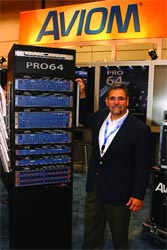- Carl Bader, Aviom's co-founder and CEO, with the Pro64 A-Net-the second generation of the company's core technology.COMPANY: Aviom
- FOUNDED: 2002
- BACKGROUND: From being a live-sound pioneer to a significant player in the installed audio network business, Aviom has always envisioned a space for itself in the contractor market.
- OVERTIME: Aviom is aware that it needs to support its customers right from the beginning and beyond, and will help them through the design process and guide them through any issues during installation and use.
- Arguably, the more established a live sound company is, the harder it is for it to change its way of doing business to suit the needs of new markets. Which perhaps explains why Aviom, barely five years old here at the back end of 2007, has gone from being a live-sound pioneer to a significant player in the installed audio network business in such a short space of time, and with the minimum of trauma.
- "Very early on, we realized that the technology we needed to develop for the monitor system could solve significant problems for people in a range of markets-including the systems contractor," said Carl Bader, Aviom's co-founder and CEO.
- When Aviom was launched by a team of professionals from the MI and pro-audio business, the company introduced two innovations: the A-16 personal mixer (now the A-16II), and the A-Net protocol. At first, most people didn't care about the technology under the hood. They just wanted a reliable solution to their problem. So, as Bader put it, for a few years Aviom was regarded as "the little blue mixer company".
- All that started to change in 2006, when Aviom launched its AV-M8 mic input module-its first product designed exclusively for the contracting sector. The AV-M8 takes eight conference mics and moves their audio over Cat-5 with the stability and simplicity of A-Net. It's not particularly glamorous, but it opened contractors' eyes to the possibilities of Aviom's approach to digital audio networking.
- Since then, Aviom has introduced its Pro64 Series of products, based on Pro64 A-Net-the second generation of the company's core technology. Bader explained the differences like this: "The first generation (Pro16 A-Net) was designed as a point-to-point system with unlimited digital splits. It was optimized for speed, simplicity, and stability. Pro64 A-Net takes those qualities and layers on the flexibility of a true network with the highest fidelity possible. In a Pro64 system, audio can be input anywhere and output everywhere. Physical location of signals and directionality are completely irrelevant, no matter what combination of parallel and serial connections a system uses.
- "Pro64 products will become even more important as more and more devices go digital and preserving clock integrity across a system becomes more challenging."
- Among all the many possible fixed-install applications for A-Net, Aviom has had particular success in the worship market. Bader acknowledges that much of this success has its roots in personal monitoring, where the company's products have allowed worship users to control the volume in their sanctuary. But as he pointed out, "Churches are doing more than monitors with Aviom. It's true that the monitor mixer is what we're best known for and what often brings a user to us initially, but it's not at all unusual for a monitor mixing system to then grow into a digital snake or distributed audio system or network. Why? Because a user has a positive experience with us and begins to see other ways to take advantage of A-Net."
- Above all, Aviom aims to be as flexible as the products it makes, and Bader cited a recent installation project, at the Las Vegas Speedway, as a prime example of how the company's thinking can benefit contractor and end customer alike. "The system designer came to us with the need to distribute 16 channels of audio to about 150 users in the press room," he recalled. "He wanted to use the A-16II personal mixer to do it. So we worked with him on a software build that put the mixer into a special 'source select only' mode. It's worked great for him, and there was no other logical way to meet the requirements of this system. It's a great illustration of taking advantage of the core design values of our technology; the product itself was secondary, at best."
Energized By Contracting










